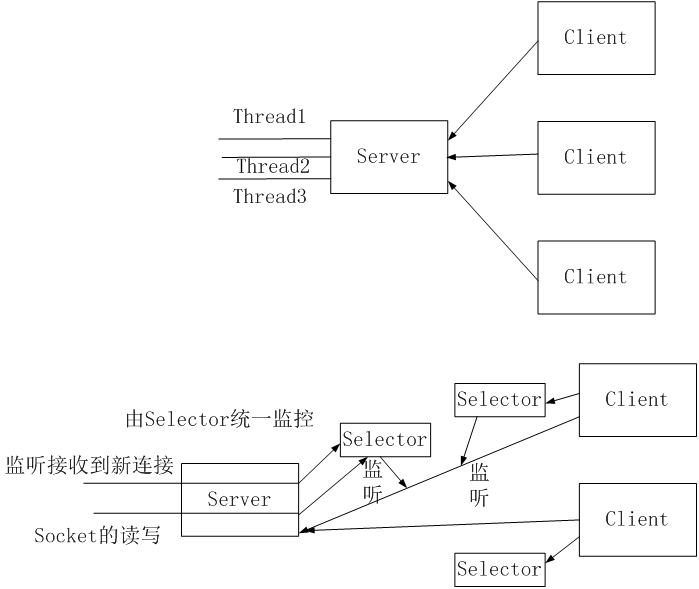Selector(选择器)是Java NIO中能够检测一到多个NIO通道,并能够知晓通道是否为诸如读写事件做好准备的组件。这样,一个单独的线程可以管理多个channel,从而管理多个网络连接。
传统的Socket IO,服务端为每个客户端连接开启一个线程来处理,这样服务器可以支持的客户端连接数是有限的。当需要处理大量的客户端连接,而每个客户端连接的数据量又不是很大时,使用Socket NIO来实现是可行的。
Socket NIO的特点是使用了Selector,使用一个线程处理多个连接的请求,向Selector中注册感兴趣的动作,Selector会在动作发生时通知接收端。
Socket NIO较Socket IO可以建立更多的连接。tomcat对NIO的支持可以看看。

下面的例子是客户端从服务器端下载文件,客户端使用了多线程技术模拟同时下载。Selector可以同时处理多个客户端的连接事件并通知服务器端进行响应操作。
服务器端的代码为:
package nio; import java.io.File; import java.io.FileInputStream; import java.net.InetSocketAddress; import java.nio.ByteBuffer; import java.nio.channels.*; import java.util.HashMap; import java.util.Iterator; import java.util.Map; import java.util.concurrent.Callable; //模拟下载服务 public class DownloadServer<T> implements Callable<T>{ //A selector may be created by invoking the open method of this class, which will use the system's default selector provider to create a new selector. //A selector may also be created by invoking the openSelector method of a custom selector provider. //A selector remains open until it is closed via its close method. //A selectable channel's registration with a selector is represented by a SelectionKey object. private Selector selector;//创建全局selector private Map<SocketChannel, Handle> map = new HashMap<SocketChannel, Handle>();//socketChannel和handle之间的映射 //创建一个服务器serverSocketChannel,并与selector进行注册 public DownloadServer() throws Exception { selector = Selector.open(); //ServerSocketChannel is a selectable channel for stream-oriented listening sockets. ServerSocketChannel serverSocketChannel = ServerSocketChannel.open(); //if false then it will be placed non-blocking mode serverSocketChannel.configureBlocking(false); serverSocketChannel.socket().bind(new InetSocketAddress(2361)); serverSocketChannel.register(selector, SelectionKey.OP_ACCEPT); //服务端接收客户端连接事件 } //对selector.select进行迭代,并依次进行处理 public T call() throws Exception { System.out.println("startTo listen in 2361...."); for(; ;) { //Selects a set of keys whose corresponding channels are ready for I/O operations //select() performs a blocking selection operation. It returns only after at least one channel is selected selector.select(); Iterator<SelectionKey> keyIterator = selector.selectedKeys().iterator(); while(keyIterator.hasNext()) { //A selectionkey is a token representing the registration of a SelectableChannel with a Selector. //A selectionkey is created each time a channel is registered with a selector. SelectionKey key = keyIterator.next(); if(key.isValid()) handle(key); keyIterator.remove(); } } } //处理每个key,对于acceptable的key,由主类进行处理,而其他事件,则由内部类进行处理 private void handle(final SelectionKey key) throws Exception { //Tests whether this key's channel is ready to accept a new socket connection. if(key.isAcceptable()) { ServerSocketChannel channel = (ServerSocketChannel) key.channel(); //Accepts a connection made to this channel's socket. SocketChannel socketChannel = channel.accept(); socketChannel.configureBlocking(false); socketChannel.register(selector, SelectionKey.OP_READ);//注册读事件 map.put(socketChannel, new Handle());//把socket和handle进行绑定 } //用map中的handle处理read和write事件,以模拟多个文件同时进行下载 if(key.isReadable() || key.isWritable()) { SocketChannel socketChannel = (SocketChannel) key.channel(); final Handle handle = map.get(socketChannel); if(handle != null) handle.handle(key); } } //内部类,模拟一个内部类处理一个文件下载服务,多个类可以处理多个文件下载服务 private class Handle{ private StringBuilder message; private boolean writeOK = true; private ByteBuffer byteBuffer = ByteBuffer.allocate(1024); private FileChannel fileChannel; private String fileName; private void handle(SelectionKey key) throws Exception { if(key.isReadable()) { SocketChannel socketChannel = (SocketChannel) key.channel(); if(writeOK) message = new StringBuilder(); while(true) { byteBuffer.clear(); int r = socketChannel.read(byteBuffer); if(r == 0) break; if(r == -1) { socketChannel.close(); key.cancel(); return; } message.append(new String(byteBuffer.array(), 0, r)); } //将接收到的信息转化成文件名,以映射到服务器上的指定文件 if(writeOK && invokeMessage(message)) { socketChannel.register(selector, SelectionKey.OP_WRITE); writeOK = false; } } //向客户端写数据 if(key.isWritable()) { //读方法中的socketChannel和写方法中的socketChannel应该是一个,不需要flip吗? if(!key.isValid()) return; SocketChannel socketChannel = (SocketChannel) key.channel(); if(fileChannel == null) fileChannel = new FileInputStream(fileName).getChannel(); byteBuffer.clear(); int w = fileChannel.read(byteBuffer); //如果文件已写完,则关掉key和socket if(w <= 0) { fileName = null; fileChannel.close(); fileChannel = null; writeOK = true; socketChannel.close(); key.channel(); return; } byteBuffer.flip(); socketChannel.write(byteBuffer); } } //将信息转化成文件名 private boolean invokeMessage(StringBuilder message) { String m = message.toString(); try { File f = new File(m); if(!f.exists()) return false; fileName = m; return true; } catch(Exception e) { return false; } } } public static void main(String[] args) throws Exception { /* ExecutorService executorService = Executors.newSingleThreadExecutor(); executorService.submit(new DownloadServer<Object>()); executorService.shutdown(); */ new DownloadServer().call(); } }
客户端的代码为:
package nio; import java.io.RandomAccessFile; import java.net.InetSocketAddress; import java.nio.ByteBuffer; import java.nio.channels.FileChannel; import java.nio.channels.SelectionKey; import java.nio.channels.Selector; import java.nio.channels.SocketChannel; import java.util.Iterator; import java.util.concurrent.Callable; import java.util.concurrent.ExecutorService; import java.util.concurrent.Executors; public class SelectorClient<T> implements Callable<T>{ private FileChannel fileChannel; private static Selector selector; private ByteBuffer byteBuffer = ByteBuffer.allocate(1024); private String serverFileName;//服务器上的文件 private String localFileName;//下载到客户端的文件名 public SelectorClient(String serverFileName, String localFileName) { this.serverFileName = serverFileName; this.localFileName = localFileName; } public T call() throws Exception { //开启selector,并建立socket到指定端口的连接 if(selector == null) selector = Selector.open(); SocketChannel channel = SocketChannel.open(); channel.configureBlocking(false); channel.connect(new InetSocketAddress("172.16.72.181", 2361)); channel.register(selector, SelectionKey.OP_CONNECT); //客户端连接服务端事件 //进行信息读取 for(; ;) { selector.select(); Iterator<SelectionKey> keyIterator = selector.selectedKeys().iterator(); while(keyIterator.hasNext()) { SelectionKey key = keyIterator.next(); keyIterator.remove(); //连接事件 if(key.isConnectable()) { SocketChannel socketChannel = (SocketChannel) key.channel(); if(socketChannel.isConnectionPending()) socketChannel.finishConnect(); socketChannel.write(ByteBuffer.wrap(serverFileName.getBytes()));//向服务器发信息,信息中即服务器上的文件名 socketChannel.register(selector, SelectionKey.OP_READ); // 读事件 } //读事件 if(key.isReadable()) { SocketChannel socketChannel = (SocketChannel) key.channel(); byteBuffer.clear(); if(!socketChannel.isConnected()) return null; //向本机下载文件创建文件channel if(fileChannel == null) fileChannel = new RandomAccessFile(localFileName, "rw").getChannel(); int r = socketChannel.read(byteBuffer); //如果文件下载完毕,则关掉channel,同时关掉socketChannel if(r <= 0) { if(fileChannel != null) fileChannel.close(); channel.close(); key.cancel(); return null; } byteBuffer.flip(); //写到下载文件中 fileChannel.write(byteBuffer); } } } } //客户端用10个线程向服务器端下载文件,并保存为不同的文件 public static void main(String[] args) throws Exception { ExecutorService executorService = Executors.newSingleThreadExecutor(); for(int i = 0; i < 10; i++) { executorService.submit(new SelectorClient<Object>("test.txt", "d:/down" + i + ".txt")); } executorService.shutdown(); } }